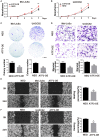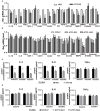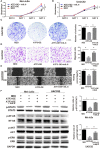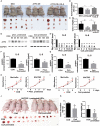Up-Regulation of Activating Transcription Factor 3 in Human Fibroblasts Inhibits Melanoma Cell Growth and Migration Through a Paracrine Pathway
- PMID: 32373541
- PMCID: PMC7187895
- DOI: 10.3389/fonc.2020.00624
Up-Regulation of Activating Transcription Factor 3 in Human Fibroblasts Inhibits Melanoma Cell Growth and Migration Through a Paracrine Pathway
Abstract
The treatment of melanoma has remained a difficult challenge. Targeting the tumor stroma has recently attracted attention for developing novel strategies for melanoma therapy. Activating transcription factor 3 (ATF3) plays a crucial role in regulating tumorigenesis and development, but whether the expression of ATF3 in human dermal fibroblasts (HDFs) can affect melanoma development hasn't been studied. Our results show that ATF3 expression is downregulated in stromal cells of human melanoma. HDFs expressing high levels of ATF3 suppressed the growth and migration of melanoma cells in association with downregulation of different cytokines including IL-6 in vitro. In vivo, HDFs with high ATF3 expression reduced tumor formation. Adding recombinant IL-6 to melanoma cells reversed those in vitro and in vivo effects, suggesting that ATF3 expression by HDFs regulates melanoma progression through the IL-6/STAT3 pathway. More importantly, HDFs pretreated with cyclosporine A or phenformin to induce ATF3 expression inhibited melanoma cell growth in vitro and in vivo. In summary, our study reveals that ATF3 suppresses human melanoma growth and that inducing the expression of ATF3 in HDFs can inhibit melanoma growth, a new potential melanoma therapeutic approach.
Keywords: activating transcription factor 3; fibroblasts; interleukin 6; melanoma; stromal cells.
Copyright © 2020 Zu, Wen, Xu, Li, Mi, Li, Brakebusch, Fisher and Wu.
Figures






Similar articles
-
ATF3 Sustains IL-22-Induced STAT3 Phosphorylation to Maintain Mucosal Immunity Through Inhibiting Phosphatases.Front Immunol. 2018 Nov 5;9:2522. doi: 10.3389/fimmu.2018.02522. eCollection 2018. Front Immunol. 2018. PMID: 30455690 Free PMC article.
-
ATF3 inhibits the inflammation induced by Mycoplasma pneumonia in vitro and in vivo.Pediatr Pulmonol. 2017 Sep;52(9):1163-1170. doi: 10.1002/ppul.23705. Epub 2017 Apr 25. Pediatr Pulmonol. 2017. PMID: 28440917
-
Metformin Inhibits Porphyromonas gingivalis Lipopolysaccharide-Influenced Inflammatory Response in Human Gingival Fibroblasts via Regulating Activating Transcription Factor-3 Expression.J Periodontol. 2017 Oct;88(10):e169-e178. doi: 10.1902/jop.2017.170168. Epub 2017 May 26. J Periodontol. 2017. PMID: 28548885
-
Inhibitory effects of pirfenidone on fibroblast to myofibroblast transition in rheumatoid arthritis-associated interstitial lung disease via the downregulation of activating transcription factor 3 (ATF3).Int Immunopharmacol. 2019 Sep;74:105700. doi: 10.1016/j.intimp.2019.105700. Epub 2019 Jun 19. Int Immunopharmacol. 2019. PMID: 31228816
-
Cardiac Fibroblast-Specific Activating Transcription Factor 3 Protects Against Heart Failure by Suppressing MAP2K3-p38 Signaling.Circulation. 2017 May 23;135(21):2041-2057. doi: 10.1161/CIRCULATIONAHA.116.024599. Epub 2017 Mar 1. Circulation. 2017. PMID: 28249877 Free PMC article.
Cited by
-
ATF3 downmodulates its new targets IFI6 and IFI27 to suppress the growth and migration of tongue squamous cell carcinoma cells.PLoS Genet. 2021 Feb 4;17(2):e1009283. doi: 10.1371/journal.pgen.1009283. eCollection 2021 Feb. PLoS Genet. 2021. PMID: 33539340 Free PMC article.
-
Phenformin activates ER stress to promote autophagic cell death via NIBAN1 and DDIT4 in oral squamous cell carcinoma independent of AMPK.Int J Oral Sci. 2024 May 8;16(1):35. doi: 10.1038/s41368-024-00297-w. Int J Oral Sci. 2024. PMID: 38719825 Free PMC article.
-
Activating transcription factor 3 (ATF3) regulates cell growth, apoptosis, invasion and collagen synthesis in keloid fibroblast through transforming growth factor beta (TGF-beta)/SMAD signaling pathway.Bioengineered. 2021 Dec;12(1):117-126. doi: 10.1080/21655979.2020.1860491. Bioengineered. 2021. PMID: 33315500 Free PMC article.
-
Identification and Validation of ATF3 Serving as a Potential Biomarker and Correlating With Pharmacotherapy Response and Immune Infiltration Characteristics in Rheumatoid Arthritis.Front Mol Biosci. 2021 Dec 13;8:761841. doi: 10.3389/fmolb.2021.761841. eCollection 2021. Front Mol Biosci. 2021. PMID: 34966780 Free PMC article.
-
ATF-3 expression inhibits melanoma growth by downregulating ERK and AKT pathways.Lab Invest. 2021 May;101(5):636-647. doi: 10.1038/s41374-020-00516-y. Epub 2020 Dec 9. Lab Invest. 2021. PMID: 33299127 Free PMC article.
References
Grants and funding
LinkOut - more resources
Full Text Sources
Research Materials
Miscellaneous

